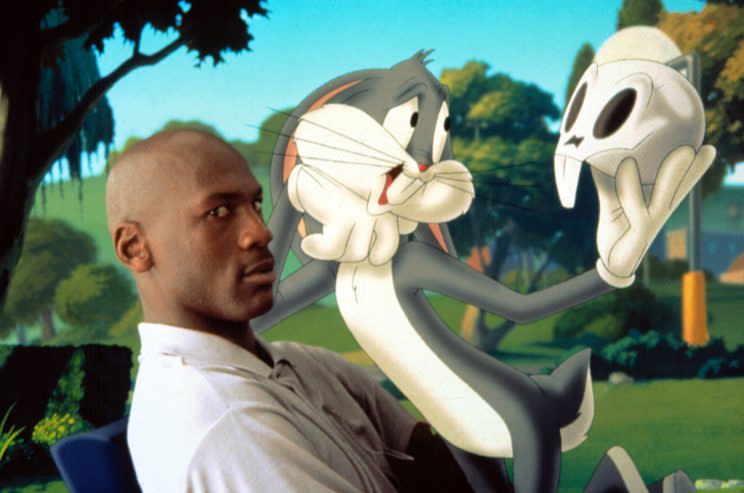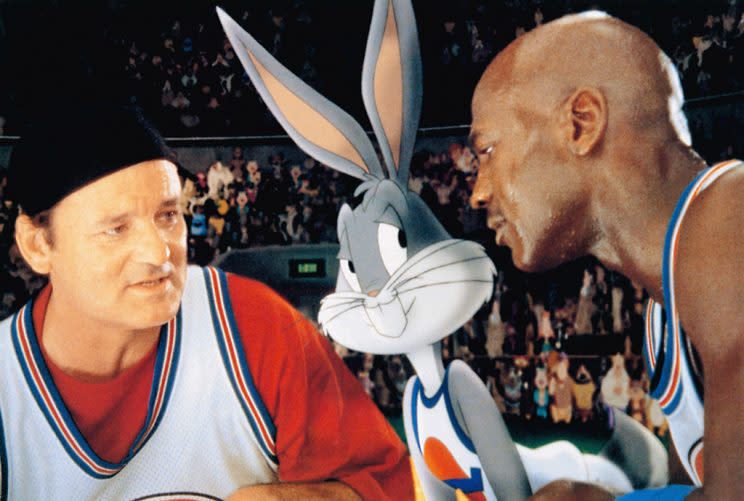'Space Jam' Turns 20: How Michael Jordan's Oddball Cartoon Mashup Became a Beloved '90s Time Capsule

By Oliver Lyttelton
Not every blockbuster movie makes a lasting impact. Twenty years ago, films like Twister, The Hunchback of Notre Dame, Ransom, and Eraser were all mammoth hits, among the biggest movies of 1996. But you hear few people clamoring for reboots, remakes, or sequels of those movies today.
One movie that has endured, though? Space Jam. The Warner Bros. family comedy teamed NBA star Michael Jordan with Bugs Bunny and the rest of the Looney Tunes gang. While it was successful, it grossed less than the movies mentioned above. Yet it has thrived in a way that many of its contemporaries haven’t, as proved by its limited return to screens this week to mark its 20th anniversary, and by the recent announcement of a reboot. How did a film mostly scorned by critics at the time prove to be such a favorite among the millennials who grew up with it?
Related: A Brief History of ‘Space Jam’ in Popular Culture
The film began as a commercial. In the aftermath of the success of 1988’s Who Framed Roger Rabbit, brands and ad agencies began to run spots that blended live action and animation in a similar way. One of the best known was Hare Jordan, a 1992 commercial for Nike (part of a deal that allowed the sportswear giant to use Looney Tunes characters) that saw Jordan step in to defend Bugs Bunny from some basketball-court bullies.
Another commercial followed the next year, which saw Jordan and Bugs head into space to retrieve some stolen Air Jordans from fellow Looney Tunes character Marvin the Martian. The success of the campaign led Jordan’s agent David Falk to approach Warner Bros. with the idea to make a whole movie based on the concept.
Watch the Nike ad:
Commercial helmer Joe Pytka, who’d directed the Nike spots, was hired for the job. The script sees Jordan — early in the baseball career he briefly switched to after retiring from basketball in 1993 — coaxed back to the game to save Bugs, Daffy Duck, and the rest of the Looney Tunes crowd from a group of aliens called the Monstars, who’ve stolen the skill of players including Charles Barkley, Shawn Bradley, and Larry Johnson. If they lose the basketball game, they’ll be forced to spend the rest of their lives in an intergalactic theme park run by the malevolent Swackhammer (voiced by Danny DeVito).
Related: Original ‘Space Jam’ Director Calls Planned Sequel Starring LeBron James ‘Doomed’
Despite the fond memories that millennials have for it, the film itself is … not great. It’s fun to see the Looney Tunes characters on screen and interacting with Jordan, but the writing for them often feels tin-eared, from sexed-up character Lola Bunny to a moment that features Porky Pig wetting himself. (It was a scene that animation legend Chuck Jones, director of the most beloved Looney Tunes shorts, particularly objected to — he called the film “terrible.”) Jordan is game but, by his own admission, isn’t a great actor. The laughs, when they come, are mostly delivered by Bill Murray, in a strange but amusing extended cameo as himself. While the mix of live action and animation is technically accomplished, it’s nowhere near as inventive or enjoyable as Roger Rabbit.

Critics mostly disliked it: It “lacks both coherence and cohesiveness,” wrote the Washington Post, though Roger Ebert was an outlier, calling it “a family movie in the best sense.” The film was a hit anyway, taking $230 million worldwide (which equates to nearly $500 million today), even as it made less money than some of the other blockbusters from around the same time.
But its success was hardly limited to the film’s theatrical run. The soundtrack, led by R. Kelly’s massive, world-conquering single “I Believe I Can Fly,” went six times platinum, and the studio estimates that the various merchandise for the movie, from video games to shower curtains, made as much as $1.2 billion. It’s in part this stuff, outside the movie, that has helped keep its pop culture footprint alive: To those who were kids at the time, Space Jam was inescapable.
Watch the ‘Space Jam’ trailer:
In some ways it still is. Unusually for 1996, Warner Bros. actually created a website for the movie, at a time when most of the public had never been on the Internet. Somehow this early, clip-art-tastic site remained live for the next two decades, and in the last few years it has become something of a cult item, a tiny time capsule of a simpler era. It’s been the subject of profiles in Rolling Stone and Vice, and even inspired a Twitter account that regularly checks in to see if it’s still up.
While talk of a reboot or sequel has been in the air for a while, it may have finally crystallized this year, with Furious 6 director Justin Lin signing on to helm a new movie that will feature Cleveland Cavaliers star LeBron James (who, unlike Jordan at the time, already has acting experience, thanks to a funny turn in Judd Apatow’s Trainwreck). Not that the original director approves — Pytka calls the attempt “doomed” because, he says, there are no stars of Jordan’s stature around anymore. As for Jordan himself? He thinks that Clippers player Blake Griffin should be the man to step into his old Jordans for the sequel.

